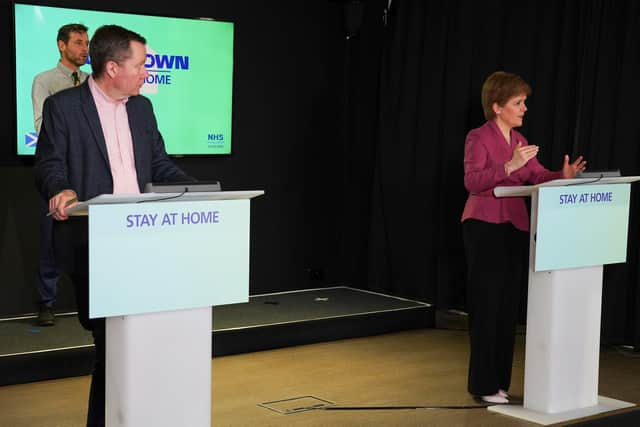Nicola Sturgeon 'rejects methodology' of critical study of Scotland's Test and Protect
The report, from Our Scottish Future, the think-tank led by former prime minister Gordon Brown, claimed Scotland's Test and Protect system was the worst in the United Kingdom.
It claimed just 32 per cent of Covid-19 cases were being picked up by the system compared to 41 per cent of England’s cases.
Advertisement
Hide AdAdvertisement
Hide AdThe study used estimated prevalence and positive tests to calculate the figure, something that was criticised by Nicola Sturgeon and Professor Jason Leitch.


Speaking at the Scottish Government’s daily coronavirus briefing, the First Minister said the statistical approach used by the think-tank was “not really appropriate”.
Ms Sturgeon said: “We would take serious issue with the methodology used here to get to the specific conclusions.
"For example, it mixes up and compares in a way that is not really appropriate, prevalence and incidence, which is not really an appropriate thing to do.
"If you look at the methodology you can see that it is flawed because it would imply that Northern Ireland in recent days has had a detection rate that is greater than 100 per cent which is clearly not possible.
"So we have significant issues with the methodology, which would mean we would question the conclusions about Scotland’s performance here compared to others.
This was further backed up by the national clinical director, who went further and labelled the central claim that Test and Protect was not working as “false”.
Prof Leitch said: “They have confused two statistical elements, which I think is unfair.
Advertisement
Hide AdAdvertisement
Hide Ad"They’ve confused prevalence, which is how much disease you have in your country, which is a modelled number, you can’t ever know, no country can know. That’s got big confidence intervals around it statistically, with incidence, which is how much you have from your positive tests, how many new cases you find each day.
"They’ve then subtracted one from another and come up with a percentage as if that is how much we find. I don’t think that’s fair and I don’t think that’s statistically correct either.
"But the fundamental truth is that you want to find as much disease as you can and isolate it from the rest of the community.
"You do that in two ways, by testing and contact tracing. We don’t test every contact because we want that disease out of circulation. We want it in homes, self-isolated, and that’s what we do very, very well.
"Our contact tracing has got very high percentages within 24 to 48 hours and our testing results come back very, very quickly.
"I am very confident that the fundamental premise of this document, which says Test and Protect isn’t working, is actually false.”
The study had claimed the failure of Test and Protect to detect two thirds of all Covid-19 cases meant it was “effectively valueless” in attempts to bring down the R number and halt the spread of Covid-19.
A message from the Editor:
Thank you for reading this article. We're more reliant on your support than ever as the shift in consumer habits brought about by coronavirus impacts our advertisers.
If you haven't already, please consider supporting our trusted, fact-checked journalism by taking out a digital subscription.
Comments
Want to join the conversation? Please or to comment on this article.